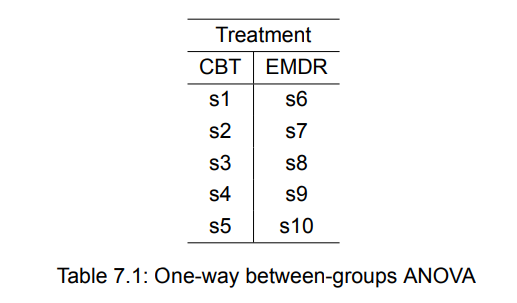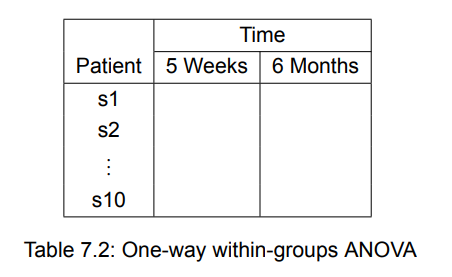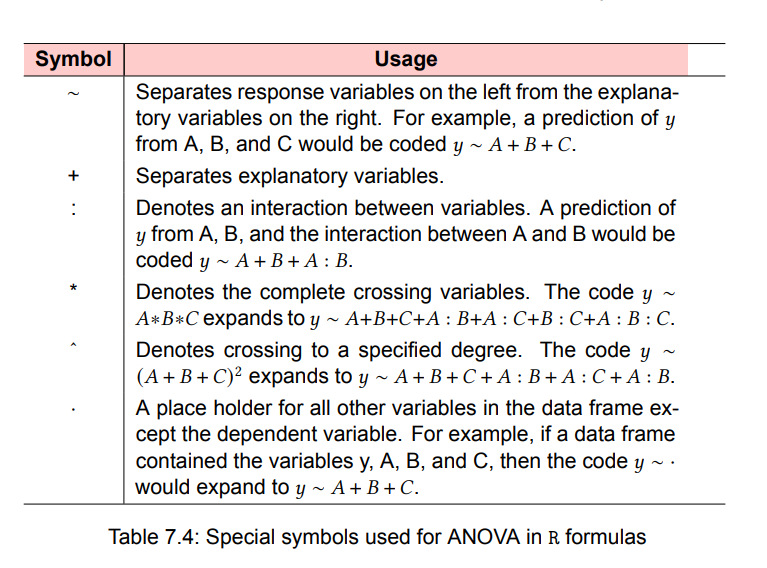Analysis of Variance ANOVA versus T test 方差分析和T检验
Levels are different groupings within the same independent variable(factor).
Eg. if the independent variable is “eggs” the levels might be Non-Organic, Organic, and Free Range Organic.
Analysis of Variance ANOVA 方差分析
Goal
whether there is a significant difference between/among the levels of the independent variables.
Assumptions
- Independence of observations
- Normality the distributions of the residuals are normal
- Equality (or "homogeneity") of variances —the variance of data in groups should be the same.
Levels are different groupings within the same independent variable(factor).
Eg. if the independent variable is “eggs” the levels might be Non-Organic, Organic, and Free Range Organic.
Eg.
You recruit 9 anxious individuals and randomly assign them to receive CBT, EMDR, M, 3 kinds of treatment for 5 weeks
Treatment is a between-groups factor with 3 levels. It’s called a between-groups factor because patients are assigned to one and only one group.

Because there are an equal number of observations in each treatment condition, you have a balanced design. When the sample sizes are unequal across the cells of a design, you have an unbalanced design.
If you are interested in the effect of CBT on anxiety over time, you could place 9 patients in the CBT group and assess them at the end of therapy and again 6 months later.
Time is a within-groups factor with two levels. It’s called a within-groups factor because each patient is measured under both levels.

within-groups ANOVA is also called repeated measures ANOVA.
Hypothesis
\(H_0\) : \(\mu_1 = \mu_2\)
One-way ANOVA
\]
\(Y_{ij}\) is the -th observation in the -th out of \(\) groups and \(\) is the overall sample size, \(n_i\) is the sample size of each group
d.f.1= K - 1
d.f.2 = N - K
The F statistic will be large if the between-group variability is large relative to the within-group variability, which means the mean value of each group is not the same.
F large, reject \(H_0\)
Two-way ANOVA
![[Pasted image 20221128143527.png]]
Therapy (averaged across time), Time (averaged across therapy type) are called the main effects, and the interaction of Therapy and Time called interaction effect.
When you cross two or more factors, as you’ve done here, you have a factorial ANOVA design. Crossing two factors produces a two-way ANOVA, crossing three factors produces a three-way ANOVA, and so forth. When a factorial design includes both between-groups and within-groups factors, it’s also called a mixed-model ANOVA. The current design is a two-way mixed-model factorial ANOVA.
In this case you’ll have three F tests: one for Therapy, one for Time, and one for the Therapy_Time interaction.
The above focus on axiety, however, depression and anxiety often co-occur. Because depression could also explain the group differences on the dependent variable, it’s a confounding factor and its value is a covariate. And if you’re not interested in depression, it’s called a nuisance variable. If you are, then the design would be called an analysis of covariance (ANCOVA)
Finally, you’ve recorded a single dependent variable in this study (the STAI ). You could increase the validity of this study by including additional measures of anxiety (such as family ratings, therapist ratings, and a measure assessing the impact of anxiety on their daily functioning). When there’s more than one dependent variable, the design is called a multivariate analysis of variance (MANOVA). If there are covariates present, it’s called a multivariate analysis of covariance (MANCOVA).
Implementation with R
aov()
- usage:
aov(formula, data = dataframe) - symbols-used-for-ANOVA-in-R-formulas

Below are formulas for several common research designs. In this table, lowercase letters are quantitative variables, uppercase letters are grouping factors, and Subject is a unique identifier variable for subjects.

Type I (sequential) Effects are adjusted for those that appear earlier in the formula. is unadjusted. B is adjusted for the . The : interaction is adjusted for and .
Type II (hierarchical) Effects are adjusted for other effects at the same or lower level. is adjusted for . is adjusted for . The : interaction is adjusted for both and .
Type III (marginal) Each effect is adjusted for every other effect in the model. is adjusted for and : . is adjusted for and : . The : interaction is adjusted for and .
R employs the Type I approach by default. Other programs such as SAS and SPSS employ the Type III approach by default.The first model can be written out as ∼ + + : . The resulting R ANOVA table will assess
• The impact of on
• The impact of on , controlling for
• The interaction of and , controlling for the and main effects.
The greater the imbalance in sample sizes, the greater the impact that the order of the terms will have on the results. In general, more fundamental effects should be listed earlier in the formula. In particular, covariates should be listed first, followed by main effects, followed by two-way interactions, followed by three-way interactions, and so on.
Note that the Anova() function in the car package provides the option of using the Type II or Type III approach, rather than the Type I approach used by the aov() function. You may want to use the Anova() function if you’re concerned about matching your results to those provided by other packages such as SAS and SPSS .
T test
Assumptions
- Independence of observations
- Normality:the distributions of the residuals are normal
- Equality (or "homogeneity") of variances —the variance of data in groups should be the same.
Analysis of Variance ANOVA 方差分析 vs T test
formulas
ANOVA: $$F = \frac{MST}{MSE} = \frac{\text{Mean sum of squares due to treatment}}{\text{Mean sum of squares due to error}}$$
t-test: 2groups (通常是两种疗法把样本分成两类)
ANOVA: 2 or more groups (one factor 2/3/4...levels (groups) / many factors)
when 2 group, n < 50 t-test; otherwise ANOVA
Analysis of Variance ANOVA versus T test 方差分析和T检验的更多相关文章
- 方差分析、T检验、卡方分析如何区分?
差异研究的目的在于比较两组数据或多组数据之间的差异,通常包括以下几类分析方法,分别是方差分析.T检验和卡方检验. 三个方法的区别 其实核心的区别在于:数据类型不一样.如果是定类和定类,此时应该使用卡方 ...
- Analysis of variance(ANOVA)
方差分析,也称为"变异数分析",用于两个及两个以上样本均值(group means)差别的显著性检验.在 ANOVA 的环境下,一个观测得到的方差视为是由不同方差的源组合而成.
- Hotelling T2检验和多元方差分析
1.1 Hotelling T2检验 Hotelling T2检验是一种常用多变量检验方法,是单变量检验的自然推广,常用于两组均向量的比较. 设两个含量分析为n,m的样本来自具有公共协方差阵的q维正态 ...
- 使用spss做方差分析
还记得上学那会老师专门敲了黑板,强调方差分析很重要..单因素方差分析(Analysis of Variance, ANOVA),如果变量多,就是多因素方差分析,还需要考虑到多重共线性, 也就是线性代数 ...
- 单因素方差分析(One Way ANOVA)
Analysis of variance (ANOVA) is a collection of statistical models and their associated estimation p ...
- SAS学习笔记26 方差分析
对于多于两组(k>2)样本均数的比较,t检验不再适用,方差分析(analysis of variance, ANOVA)则是解决上述问题的重要分析方法.方差分析由R.A.Fisher(1923) ...
- 方差分析(python代码实现)
python机器学习-乳腺癌细胞挖掘(欢迎关注博主主页,学习python视频资源,还有大量免费python经典文章) https://study.163.com/course/introduction ...
- ANOVA (paper from the onlinestat)
Introduction Author(s) David M. Lane Prerequisites Variance, Significance Testing,All Pairwise Compa ...
- [Reship]如何回复审稿人意见
================================= This article came from here:http://blog.renren.com/GetEntry.do?id= ...
- Multiple Regression
Multiple Regression What is multiple regression? Multiple regression is regression analysis with mor ...
随机推荐
- IT工具知识-08:如何使用Openwrt下的SMB服务(第一次使用时)?
0.背景知识 使用固件:Lean的R20.5.9由flippy打包 需要软件:ssh客户端(我用的xshell),浏览器(最好是chrome内核) 1.使用教程 1.1 注释掉SAMBA模板中的某条指 ...
- vscode配置c++环境(超简单)
vscode配置c++环境(超简单) 超简单!!! 配置c++最麻烦的就是mingw的环境,有很多不同的版本,很杂乱,这里我们用最简单的办法展示. 下载一个devc++. 如果你问我,为什么下了dev ...
- [Cisco] IOS NAT Load-Balancing for Two ISP Connections
interface FastEthernet0 ip address dhcp ip nat outside ip virtual-reassembly ! interface FastEtherne ...
- hhtp协议和html标签分类css
HTTP协议四大特性: 1基于请求响应 2 基于tcp/ip协议之上的应用层协议 3 无状态 不能保存用户信息 4 无链接,短链接 二 get和post的区别? 1 get 不安全,get请求没有请求 ...
- 使用npm包API Promise化
- WPF中转换与关键帧动画及报错:WPF动画找不到依赖属性:属性未指向路径“(0).(1)[3].(2)”中的 DependencyObject
WPF中的转换有: // 在二维 x-y 坐标系内围绕指定点按顺时针方向旋转对象. <RotateTransform /> // 在二维 x-y 坐标系中平移(移动)对象. <Tra ...
- mysql替换空格制表符换行
update ztbdb_pro set pro=REPLACE(pro,CHAR(10),''); update ztbdb_pro set pro=REPLACE(pro,CHAR(13),'') ...
- 在Mac上不常用但会用到的命令
文章目录 1. chflags 2. rename 1. chflags chflags hidden filename 给文件添加隐藏属性 chflags nohidden filename 去掉文 ...
- 笔精墨妙,妙手丹青,微软开源可视化版本的ChatGPT:Visual ChatGPT,人工智能AI聊天发图片,Python3.10实现
说时迟那时快,微软第一时间发布开源库Visual ChatGPT,把 ChatGPT 的人工智能AI能力和Stable Diffusion以及ControlNet进行了整合.常常被互联网人挂在嘴边的& ...
- Windows 10 ltsc 2021 (2021/11/17更新版本)
Windows 10 Enterprise LTSC 2021 (x86) - DVD (Chinese-Simplified)文件:SW_DVD9_WIN_ENT_LTSC_2021_32BIT_C ...
